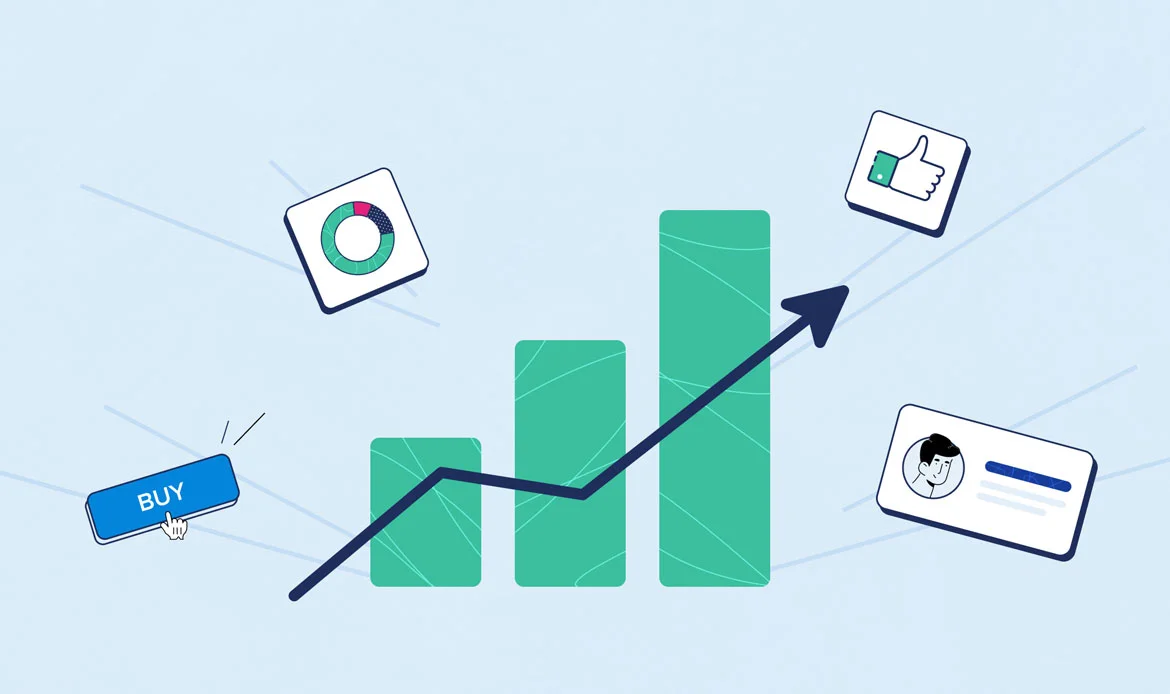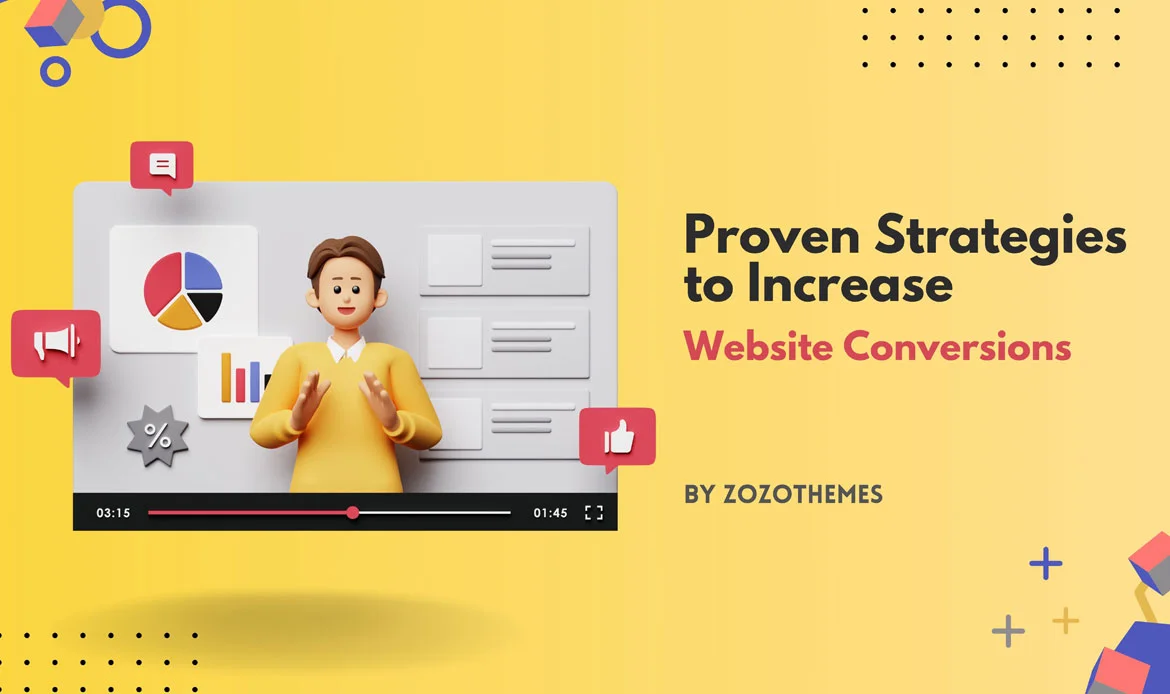What is Website Conversion?
Website conversion refers to the process of getting visitors to take a desired action on your website. This action can vary depending on the goals of your website and business. Typically, website conversion involves encouraging visitors to perform actions such as making a purchase, signing up for a newsletter, filling out a contact form, downloading a resource, or any other action that aligns with your business objectives. Conversion is a crucial metric in online marketing and e-commerce, as it directly impacts a website’s effectiveness in achieving its goals. The percentage of visitors who complete the desired action is referred to as the “conversion rate.” A high conversion rate indicates that a significant portion of your website’s visitors are taking the desired actions, which is a key indicator of a successful online presence.What is the Website Conversion Rate?
 The website conversion rate is a crucial metric that quantifies the effectiveness of your website in getting visitors to take a specific desired action. This rate is typically expressed as a percentage and is calculated by dividing the number of visitors who completed the desired action by the total number of visitors to your website within a specific time frame. The formula for calculating the website conversion rate is:
Conversion Rate = (Number of Conversions / Total Number of Visitors) × 100%
For example, if your website had 500 visitors in a month, and 50 of them made a purchase, your conversion rate would be:
Conversion Rate = (50 / 500) × 100% = 10%
In this scenario, your website’s conversion rate is 10%, meaning 10% of the visitors made a purchase.
A higher conversion rate is generally desirable as it indicates that a significant portion of your website’s visitors are taking the desired action, whether it’s making a purchase, signing up for a newsletter, or another goal that aligns with your business objectives. Low conversion rates may indicate that your website needs optimization, which could involve improving the user experience, optimizing content, enhancing calls to action, or other strategies to encourage more conversions.
The website conversion rate is a crucial metric that quantifies the effectiveness of your website in getting visitors to take a specific desired action. This rate is typically expressed as a percentage and is calculated by dividing the number of visitors who completed the desired action by the total number of visitors to your website within a specific time frame. The formula for calculating the website conversion rate is:
Conversion Rate = (Number of Conversions / Total Number of Visitors) × 100%
For example, if your website had 500 visitors in a month, and 50 of them made a purchase, your conversion rate would be:
Conversion Rate = (50 / 500) × 100% = 10%
In this scenario, your website’s conversion rate is 10%, meaning 10% of the visitors made a purchase.
A higher conversion rate is generally desirable as it indicates that a significant portion of your website’s visitors are taking the desired action, whether it’s making a purchase, signing up for a newsletter, or another goal that aligns with your business objectives. Low conversion rates may indicate that your website needs optimization, which could involve improving the user experience, optimizing content, enhancing calls to action, or other strategies to encourage more conversions.
Average Website Conversion Rate by Industry
 Website conversion rates can vary significantly by industry due to differences in target audiences, products or services offered, and the nature of the desired actions. While there’s no one-size-fits-all benchmark for conversion rates, here’s a general guideline of average conversion rates by industry based on available data up to my knowledge cutoff date in January 2022. Keep in mind that these figures are approximate, and actual rates can vary based on numerous factors:
Website conversion rates can vary significantly by industry due to differences in target audiences, products or services offered, and the nature of the desired actions. While there’s no one-size-fits-all benchmark for conversion rates, here’s a general guideline of average conversion rates by industry based on available data up to my knowledge cutoff date in January 2022. Keep in mind that these figures are approximate, and actual rates can vary based on numerous factors:
E-commerce:
The average e-commerce conversion rate typically falls in the range of 2% to 5%. High-performing e-commerce sites can achieve conversion rates above 5%.SaaS (Software as a Service):
SaaS websites often have conversion rates between 3% and 7%. The software industry is competitive, and the conversion rate can vary depending on the product and its pricing.Lead Generation:
Lead generation websites, such as those in the insurance and real estate industries, tend to have conversion rates of around 5% to 10% or higher. These websites aim to collect user information through forms.Travel and Hospitality:
Conversion rates in the travel industry can range from 1% to 4%. These sites often have longer buying cycles, and conversion may involve booking a trip or accommodation.Finance and Banking:
Conversion rates in the finance sector can vary widely, from 2% to 10% or more. Rates can be influenced by the specific financial services offered and the trust factor.Healthcare and Pharmaceuticals:
Healthcare websites often have lower conversion rates, typically around 1% to 3%. These websites often focus on providing information rather than direct sales.Media and Publishing:
Conversion rates for media and publishing websites can range from 2% to 8%. These websites may focus on newsletter sign-ups, subscriptions, or content downloads.Nonprofits:
Nonprofit websites may see conversion rates of 5% to 15% or more, as their goals often include collecting donations or securing volunteers.Education:
Education websites can have conversion rates between 2% and 8%. These websites aim to get visitors to enroll in courses or programs.Real Estate:
Real estate websites may have conversion rates between 2% and 5%. Conversions often involve lead generation or property inquiries. Remember that these are rough estimates, and your specific website’s performance may vary. It’s essential to set your own conversion rate benchmarks based on your industry, your unique business objectives, and your historical data. Regularly tracking and analyzing your website’s conversion rates and conducting A/B testing can help you identify areas for improvement and optimize your site for better results.Strategies to Increase Website Conversions

1. Optimize Page Load Speed to Increase Website Conversions
A fast-loading website is one of the easiest ways to increase website conversions. Visitors expect instant access to information, and a delay of even a few seconds can cause them to bounce. By compressing images, using caching, and optimizing code, you can create a seamless browsing experience that keeps users engaged and more likely to take action.Implementation:
- Compress images and use efficient coding.
- Use a content delivery network (CDN) to cache and deliver content faster.
- Minimize HTTP requests by reducing unnecessary elements.
2. Craft Compelling Call-to-Action (CTA) Buttons to Increase Website Conversions
Clear and visually appealing CTA buttons are essential to increase website conversions. Action-driven words like “Get Started” or “Claim Your Offer” guide users toward the next step. Placing CTAs strategically throughout your site ensures visitors don’t miss opportunities to interact with your brand.Implementation:
- Use contrasting colors for CTA buttons to make them visually distinct.
- Use action words like “Get Started,” “Download Now,” or “Subscribe.”
- Position CTAs strategically, such as at the end of blog posts or on product pages.
3. Conduct A/B Testing to Increase Website Conversions
A/B testing allows you to compare different versions of your website elements—like headlines, layouts, or images—to see what drives more conversions. This data-driven approach helps you continuously refine and increase website conversions by understanding exactly what resonates with your audience.Implementation:
- Use A/B testing tools like Google Optimize or Optimizely.
- Test elements like headlines, images, CTAs, and forms to see what resonates with your audience.
- Make data-driven decisions based on test results.
4. Leverage Social Proof to Increase Website Conversions
Showcasing testimonials, reviews, and case studies builds trust with potential customers. People are more likely to engage when they see others have had positive experiences. Social proof adds credibility and can significantly increase website conversions.Implementation:
- Encourage satisfied customers to leave reviews.
- Display star ratings, testimonials, and user-generated content.
- Use trust badges to demonstrate your business’s credibility.
5. Simplify Forms to Increase Website Conversions
Long or complicated forms often discourage users. By reducing the number of required fields and keeping forms straightforward, you create a smoother process that helps increase website conversions. The simpler it is, the more likely users are to complete the action.Example:
Dropbox Dropbox keeps their sign-up form incredibly simple, requiring only essential information. This reduces friction and encourages more sign-ups.How to Implement:
- Minimize the number of required form fields.
- Use auto-suggestions and validation to assist users.
- Implement multi-step forms to break down complex processes.
6. Implement Live Chat Support to Increase Website Conversions
Real-time support reassures users that their questions will be answered quickly. A live chat feature adds convenience, builds trust, and helps increase website conversions by removing obstacles in the decision-making process.Example:
Zendesk Zendesk provides a live chat feature to help users instantly get assistance. This can prevent potential customers from abandoning the website due to questions or concerns.How to Implement:
- Use live chat plugins or software like Intercom or Drift.
- Ensure knowledgeable and responsive support agents are available.
- Set up proactive chat invitations based on user behavior.
7. Develop High-Quality Content to Increase Website Conversions
Engaging blog posts, guides, and landing page content attract visitors and persuade them to take action. Quality content not only informs but also builds authority, helping increase website conversions by keeping users interested and confident in your brand.Example:
Moz Moz’s blog is filled with in-depth, informative content that establishes them as an authority in the SEO industry. This content not only educates visitors but also builds trust.How to Implement:
- Create valuable and relevant content for your target audience.
- Use visuals, videos, and infographics to engage users.
- Maintain a consistent content schedule to keep users coming back.
8. Mobile Optimization to Increase Website Conversions
With most users browsing on smartphones, mobile optimization is essential. A responsive, user-friendly mobile design ensures visitors can easily navigate and convert, helping increase website conversions across all devices.Example:
Airbnb Airbnb provides a seamless mobile experience by offering a user-friendly app and a responsive mobile website. This caters to users who prefer mobile devices for browsing and booking.How to Implement:
- Use responsive design to ensure your website adapts to various screen sizes.
- Prioritize mobile speed and load times.
- Test your website on different mobile devices to ensure a smooth experience.
9. Personalize User Experiences to Increase Website Conversions
Personalization—like showing tailored product recommendations or personalized messages—creates a stronger connection with visitors. This personal touch builds relevance and directly helps increase website conversions.Example:
Netflix Netflix tailors its homepage for each user, recommending content based on their viewing history and preferences. This personalization encourages users to engage more with the platform.How to Implement:
- Use cookies and user data to customize content recommendations.
- Create dynamic content that adapts to user behavior and preferences.
- Implement personalization at various touchpoints, such as emails and product recommendations.
10. Clear and Compelling Value Proposition to Increase Website Conversions
Your website must quickly communicate why visitors should choose you. A clear value proposition highlights your unique benefits and helps increase website conversions by convincing users that your offering is the best solution.Example:
Slack Slack’s homepage clearly communicates its value proposition – “Where work happens.” Users immediately understand the platform’s purpose and how it can benefit them.How to Implement:
- Craft a concise and compelling value proposition.
- Highlight how your product or service solves users’ problems.
- Ensure your value proposition is prominent on your website.
11. Implement Exit-Intent Popups
Exit-intent popups capture visitors just as they’re about to leave. Offering discounts, free trials, or lead magnets can encourage them to stay, boosting engagement and helping increase website conversions. They can re-engage users by offering incentives or valuable content.Example:
OptinMonster OptinMonster uses exit-intent popups to re-engage visitors who are about to leave the site. They offer discounts, content upgrades, or newsletter subscriptions to entice users to stay.How to Implement:
- Use exit-intent popup software to detect when users are leaving.
- Offer value, such as discounts, eBooks, or exclusive content.
- Design visually appealing and unobtrusive popups.
12. Use Urgency and Scarcity
Limited-time offers, countdown timers, and low-stock alerts create urgency. These psychological triggers motivate users to act quickly and can effectively increase website conversions. Urgency and scarcity tactics create a sense of FOMO (fear of missing out) that motivates users to take action quickly, such as making a purchase.Example:
Booking.com Booking.com leverages urgency and scarcity by displaying messages like “Only 2 rooms left” or “Booked 10 times in the last 24 hours.” This motivates users to make quick decisions.How to Implement:
- Use countdown timers for limited-time offers.
- Display low-stock or high-demand messages.
- Highlight seasonal promotions and limited-time sales.
13. Simplify Navigation
Cluttered menus and confusing layouts frustrate visitors. A streamlined, intuitive navigation system helps users find what they need faster, reducing drop-offs and helping increase website conversions. Simple and clear navigation makes it easy for users to find what they’re looking for on your website. A clutter-free menu enhances the user experience.Example:
Apple Apple’s website features a clean and straightforward navigation menu. This makes it easy for users to find products, explore services, and access support.How to Implement:
- Streamline your website’s menu to reduce clutter.
- Use clear and concise labels for navigation items.
- Prioritize user-friendly navigation on both desktop and mobile.
14. Optimize for Local SEO
Local SEO ensures your business appears in local search results, attracting highly relevant traffic. Optimizing Google Business profiles and local keywords helps drive the right visitors, increasing website conversions from nearby customers.Example:
Yelp Yelp optimizes for local SEO, ensuring that users searching for local businesses find relevant results. They also encourage users to leave reviews and engage with local businesses.How to Implement:
- Claim your Google My Business listing and keep it updated.
- Optimize your website for local keywords and create local landing pages.
- Encourage satisfied customers to leave reviews on platforms like Yelp and Google.
15. Collect User Surveys and Feedback
Feedback offers insights into what users like or dislike about your site. Acting on this data improves usability and customer satisfaction, ultimately helping increase website conversions over time. Gathering user feedback through surveys helps you understand your audience’s needs and pain points, leading to website improvements.Example:
SurveyMonkey SurveyMonkey, a platform for creating and analyzing surveys, practices what it preaches. They use surveys to gather user feedback, enabling data-driven improvements to their service.How to Implement:
- Create user surveys to gather feedback on your website and products.
- Analyze survey results to identify pain points and areas for improvement.
- Act on user feedback to enhance the user experience.
1. How can I Increase Website Conversions with 20 Proven Strategies?
You can increase website conversions with 20 proven strategies by focusing on user experience, optimizing page speed, crafting strong CTAs, simplifying navigation, and adding personalization. When applied together, these strategies create a seamless journey that guides visitors toward becoming customers.
2. Are these 20 proven strategies effective for all types of businesses?
Yes, the 20 proven strategies to increase website conversions work across industries. Whether you run an eCommerce store, a service-based company, or a personal brand, tactics like A/B testing, mobile optimization, and social proof can be tailored to suit your audience and drive better results.
3. How quickly can I see results from these strategies?
The timeline to increase website conversions depends on your current website performance. Some strategies, like improving page load speed or refining CTAs, can deliver quick wins within weeks, while others, like SEO optimization or personalization, may take a few months for maximum impact.
4. Do small businesses benefit from these 20 proven strategies?
Absolutely. Small businesses often see faster results because even small changes—such as simplifying forms or adding live chat—can significantly improve engagement. Implementing these strategies helps level the playing field against larger competitors and increases website conversions effectively.
5. What tools can help implement these 20 strategies to increase website conversions?
Tools like Google Analytics, Hotjar, A/B testing platforms, and live chat software make it easier to track performance and optimize your site. Using these tools alongside the 20 proven strategies ensures you continuously refine your approach and maximize conversions.
Conclusion
Implementing these 20 proven strategies to increase website conversions is not just about making quick changes; it’s about creating a long-term system that consistently drives results. From personalization and mobile optimization to A/B testing and clear value propositions, every step you take builds trust and encourages action. Start applying these strategies today, and watch how your website transforms into a high-performing conversion machine that fuels sustainable business growth.Take Action Now – Increase Website Conversions with 20 Proven Strategies
Don’t just attract visitors—turn them into loyal customers. By applying these 20 proven strategies, you can optimize every touchpoint of your website, boost engagement, and drive higher revenue. The time to act is now. Start implementing these strategies today and watch your website conversions rise dramatically.


